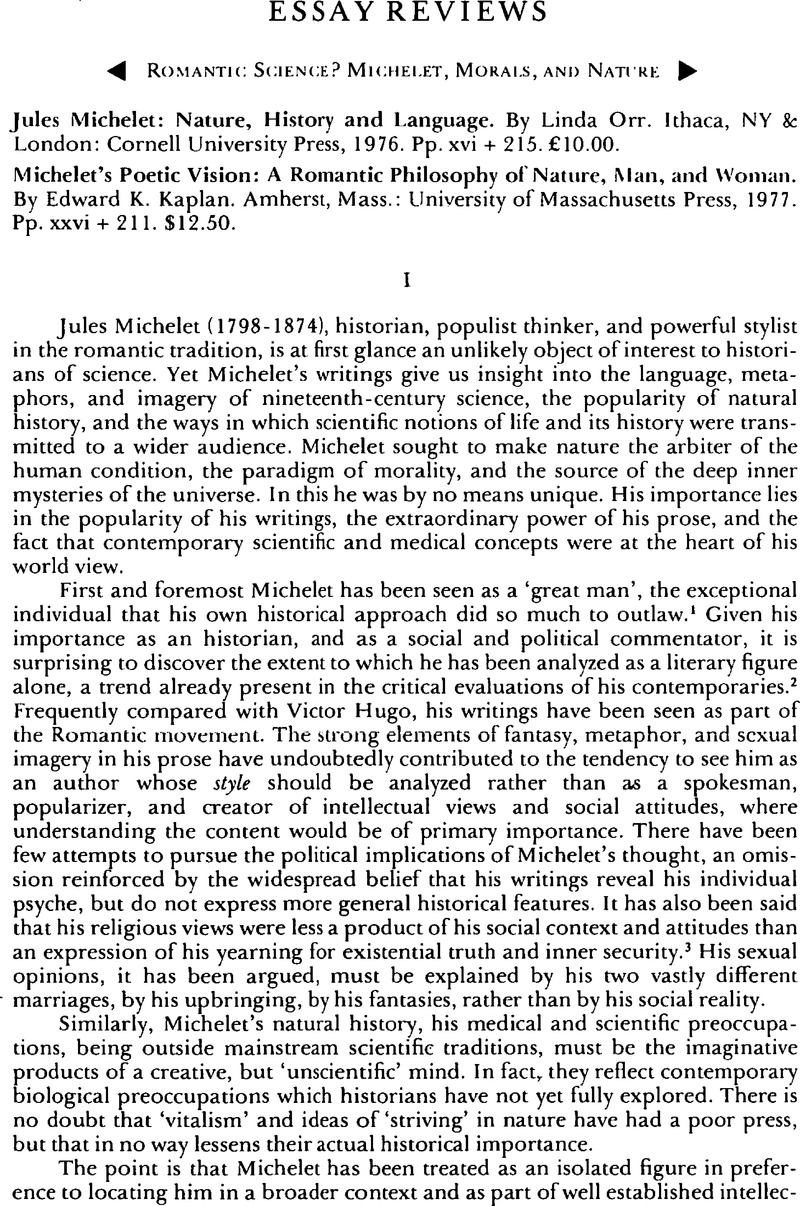No CrossRef data available.
Published online by Cambridge University Press: 05 January 2009

1 See, for example, Michelet, J., Histoire de la France, 17 vols., Paris, 1833–1867Google Scholar; Histoire de la révolution française, 7 vols., Paris, 1847–1853Google Scholar. On Michelet's reputation as a historian see Wilson, E., To the Finland station: a study in the writing and acting of history, New York, 1940Google Scholar; and Johnson, D., ‘Michelet á la mode’ The Times literary supplement, 1977, 542–3.Google Scholar
2 For a bibliography of contemporary comments on Michelet, see Thième, H. P., Bibliographie de la littérature française de 1800 à 1930, 3 vols., Paris 1933, ii, 316–20.Google Scholar
3 Johnson, M. E., Michelet et le christianisme, Paris, 1955Google Scholar. More satisfactory accounts may be found in Chadwick, O., The secularization of the European mind in the nineteenth century, Cambridge, 1975Google Scholar; and in Charlton, D. G., Secular religions in France (1815–1870), London, 1963.Google Scholar
4 Roussel, P., Système physique et moral de la femme, ou tableau philosophique de la constitution, de l'état organique, du tempérament, des moeurs, et des fonctions propres au sexe, Paris, 1775 (2nd edn., Paris, 1803)Google Scholar. Knibiehler, V., ‘Les médians et la ‘nature féminine’ au temps du code civil’, Annales: économies, sociétés, civilisations, 1976, 31, 824–45.CrossRefGoogle Scholar
5 Among the best examples of this is Michelet, 's Tableau de la France, published in 1833Google Scholar as an introduction to volume ii of his Histoire dela France.
6 The appeal to anatomy is made in the introduction to La Femme, Paris, 1859, pp. xlix–lix.Google Scholar
7 Seznec, J., ‘Michelet in Germany: La journey in self-discovery’, History and theory, 1977, 16, 1–10 (1).CrossRefGoogle Scholar
8 Michelet, J., L'Amour, Paris, 1858Google Scholar; La Femme, Paris, 1859Google Scholar; Du prêtre, de la femme de la famille, Paris, 1845.Google Scholar
9 It is significant that Michelet's anti-clericalism laid great stress on the excessive power priests had over women. He wished doctors and husbands to influence female behaviour instead. He particularly admired the work of hygienists and anatomists as having a humanizing effect on the treatment of women. Michelet's attitude to medicine gives an interesting perspective to the professional struggles in nineteenth-century France.
10 p. Viallaneix, , La voie royale: essai sur l'idée de peuple dano l'oeuvre de Michelet, new edn., Paris, 1971Google Scholar; Barthes, R., Michelet, Paris, 1954Google Scholar; Pugh, A. R., Michelet and his ideas on social reform, New York, 1923Google Scholar; Monod, G., Jules Michelet, Paris, 1875Google Scholar; Monod, G., Jules Michelet, Etudes sur sa vie et ses oeuvres, Paris, 1914Google Scholar; Halévy, D., Jules Michelet, Paris, 1928.Google Scholar
11 See the special issue of Romantisme, ed. by Villaneix, P., ‘Michelet cent ans après’, Grenoble, 1975Google Scholar; and that of Revue d'histoire litteéraire de la France, 1974, 74Google Scholar. On the the popularity of Michelet's nonhistorical works, see Zeldin, T., France, 1848–1945, 2 vols., Oxford, 1973, 1977, ii, 386–7CrossRefGoogle Scholar; and Michelet, J., The people (ed. and trans, by McKay, J. P.), Urbana, Ill., Chicago, & London, 1973, p. ix.Google Scholar
12 The dates given in parentheses are those of the first editions. These works were quickly translated into English and distributed in both Britain and the United States. Kaplan, E. K., Michelet's poetic vision: a romantic philosophy of nature, man and woman, Amherst, 1977, pp. 194–5Google Scholar gives details of some of these translations.
13 For example, Benton, E., ‘Vitalism in nineteenth-century scientific thought: a typology and reassessment’, Studies in history and philosophy of science, 1974, 5, 17–48.CrossRefGoogle ScholarPubMed
14 See for instance Rudé, G., Interpretations of the French Revolution, revised edn., London, 1972Google Scholar, which can usefully be compared with Cobban, A., Historians and the causes of the French Revolution, revised edn., London, 1958.Google Scholar
15 The most extensive analysis of Michelet's attitudes to women is Calo, J., La Création de la femme chez Michelet, Paris, 1975.Google Scholar
16 The secondary literature on Lamarckism is as yet rather poor and relates mostly to American sources. More useful might be Dantec, F. Le, Lamarckiens et Darwiniens: discussion de quelques théories sur la formation des espèces, Paris, 1899Google Scholar; and Landrieu, M., Lamarck, le fondateur du trans-formisme: sa vie, son oeuvre, Paris, 1909Google Scholar. More references to the primary and secondary literature on Lamarckism may be found in Jordanova, L. J., ‘The natural philosophy of Lamarck in its historical context’, University of Cambridge PhD thesis, 1976, especially chapters I and II.Google Scholar
17 Ravaisson, F., La Philosophie en France au XIXe siècle, Paris, 1867Google Scholar; Copleston, F., A history of philosophy. Volume ix: Maine de Biran to Sartre, London, 1975, chapters VIII–X.Google Scholar
18 See, for example, Waddell, M. J., ‘The idea of nature: George Eliot and her intellectual milieu’, University of Cambridge PhD thesis, 1977Google Scholar; Beer, G., ‘Determinism and the self in George Eliot and Virginia Woolf’, in Jacobus, M. (ed.), The difference of view: essays on women writers and women in literature, London, 1979.Google Scholar